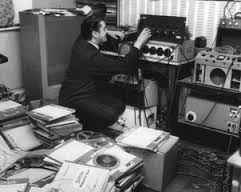Joe Meek (1929-67) Recording engineer and record producer. Brilliant chap!
57th anniversary of his passing, I had to write something. For those of us that grew up in the ‘60s, Joe Meek may be a familiar name. I would call him one of the truly innovate record producers / sound engineers Britain had. I had a 45rpm of Monte Carlo, by the Tornados on the Decca label, which was one of his productions, I wore it out!
As a youngster, Joe realised his love for electronics, taking over his father’s shed, modifying radio sets and making all sorts of electronic gear. After finishing National Service as a radar engineer, he worked for the Electricity Board in the Midlands. He had become very interested in music production and recording and managed to acquire a secondhand record disc cutting machine.
Joe left the Electric Board and joined a radio production company, making material for independent record labels and radio stations such as Luxemburg. He gained much admiration following his work on the recordings of the Ivy Benson’s all-girl Dance Band and Jazz Trumpeter Humphrey Littleton. Joe understood the importance of “engineering” the recordings. Remember, in the late ‘50s for most of us, all we had were AM, Medium wave wireless sets and 78 rpm records. These had very limited frequency and dynamic ranges. So, to make the most of that, Meek compressed, topped-tailed the recordings, so that they sounded as good as possible when played on little record players and budget radios. Humphrey Littleton recalled that on a recording of ‘Bad Penny Blues’, Meek had compressed and uplifted the piano to give a big thumping presence. Littleton went mad, as recording was released without his hearing it first. He thought it didn’t sound original. However, it was a smash hit Well, got in the Top 20!
In 1960, Meek set up Triumph Records and eventually moved into a 3 storey flat above a leather shop in London’s Holloway Road. One room was a control room, with lots of home-made recording equipment. 2 track tape machines, mixers, echo chambers, compressors etc. Ferrograph, Vortexion, EMI, all household equipment names. Other rooms contained various microphones and special effects gear. He would have piano and guitars in one room, drums and bass in others and some vocalists in his bathroom. Musicians such as Joe Brown often complained of getting electric shocks from microphones and guitars! Artists recording there included Lonnie Donegan (Cumberland gap), Johnny Leyton (Just Like Eddie), The Honeycombs (Have I the right) and of course The Tornados with Telstar, which was a number one hit in ’62. This set Joe up as the go-to producer. A classic example of Meek’s playing around with recordings, can be heard at the beginning to the record Telstar. The strange Sci-Fi mechanical sound introduction, was actually a recording of an old tractor played at a slower speed and backwards. His recordings were over-dubbed many times, adding different instruments and vocal and effects. This detracted from HiFi quality. The record companies Joe used to press the records always complained about the quality of the recordings. But Meek knew this would produce a distinctive sound. It did. And, people loved it.
Joe was known to be hard to work with and during the mid ‘60s, was running into financial problems. The royalties for the record Telstar, Joe never got. A French composer said Joe had copied his tune. The case was eventually dropped, after Joe’s death. The remains of his recording company was awarded £3 million. He was convinced that Decca Records was bugging his studio to steal his recording secrets and would not let anyone into the building if he was not there. He had a real “thing” about communicating with the dead and would leave tape machines running all night in the hope of recording voices from the other side. He produced the Mike Berry recording “Tribute to Buddy Holly” following Buddy’s death. Of course, being gay in the 60s was a bit of a problem and in ’63 was fined for importuning. He never recovered from this and it fed an on-going depression. Many musicians slipped through his hands and It’s said that Brian Epstein asked Meek what he thought of a group called the Beatles. Joe said don’t sign them up, they’re no good! Another faux pas was his agreeing to record a small band as long as the signer was replaced. The signer being a young Rod Stewart. In ’67, in his recording studio, Meek shot himself after killing his landlady.
It is very sad thinking about someone who paved the way for modern recording techniques ended up like this. He was an early experimenter with compression, reverb, direct connection of instruments into recording desks, multi-tracking and so on. Phil Spector, well known for his “Wall-Of-Sound” image, said that he owed much of this to Meek’s own inventiveness. I could go on and on, but not enough pages.
So, off to pop my copy of Telstar on the radiogram. Listening Joe? Pop into my shop one day.
Seth Pittham. Zeta services



